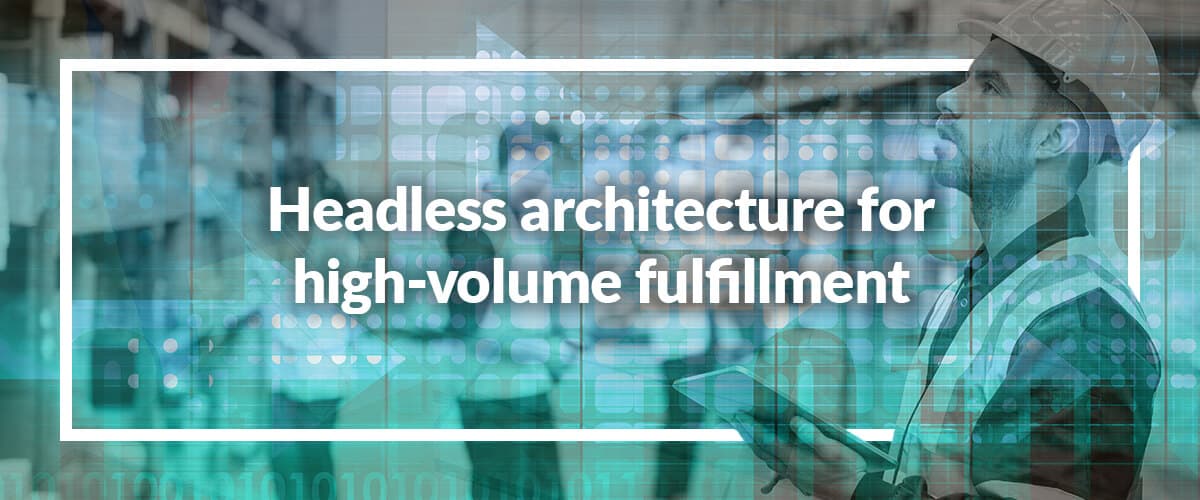Headless architecture is a software development environment that supports decoupling the front-end user interface from the back-end processing and data management functions. Fulfillment management systems (FMS) like Logiwa IO that utilize a headless architecture allow end users to customize add-ons and the user interface and integrate seamlessly with other tools and systems.
Logiwa IO’s use of headless architecture empowers fulfillment operations to tailor the UI to fit their specific needs. This allows the seamless integration of other business systems and custom solutions without interfering with the back-end systems. Such flexibility makes headless API the go-to approach for fast-scaling ecommerce platforms that need to constantly iterate their front-end user interface and integrations to satisfy evolving fulfillment needs across different channels like mobile, web, and IoT devices.
This blog explores the concept of headless architecture in detail and how it impacts WMS and FMS platforms. We’ll also highlight how Logiwa IO leverages headless architecture to effectively tackle current and future ecommerce fulfillment challenges.
Let’s jump in.
Contents
What is headless architecture?
In headless architecture, the front-end logic is decoupled from the back end. This means that front-end elements, such as connecting bots and user interfaces, operate independently from the back-end elements, such as business logic, static files, application servers, and database servers. However, the front end can still seamlessly connect and sync with the back end through application programming interfaces or APIs.
Headless vs. traditional architecture
Unlike headless architecture that decouples front-end and back-end, traditional monolithic architecture fuses front-end and back-end elements. The tight integration in traditional architecture curtails the flexibility and scalability of user interface development. Since changes made to the front end impact the back end too, users of those systems are often stuck with limitations, or face expensive custom development fees.
Why headless architecture matters in ecommerce fulfillment
The robust back-end functionality and front-end independence that headless architecture supports give fulfillment platforms the much-needed agility and scalability to accommodate changing ecommerce needs. The ecommerce sector is dynamic thanks to the numerous tech-driven trends influencing retail shopping. Thus, fulfillment platforms must continually improve and embrace innovations like integrating AI and omnichannel ecommerce marketplaces.
With a headless fulfillment platform, you can add new front-end solutions like custom picking interfaces, OMS applications, or preferred shipping solutions. They’ll automatically sync with the existing API and sustain the integrity of the back-end system. The ease of creating and integrating custom front-end experiences or adding integrations to a headless fulfillment platform helps you keep up with developing ecommerce fulfillment trends.
How headless architecture addresses modern ecommerce fulfillment challenges
Headless architecture empowers high-volume fulfillment operations to quickly modify their front-end system to get ahead of diverse fulfillment challenges. In today’s hyper-competitive ecommerce sector, fulfillment needs change continually as online shoppers expect better shopping experiences every day. Headless architecture helps operations rise above ever-changing fulfillment needs by:
- Boosting innovation speed: Headless architecture enables swift improvement of front-end components, such as design elements, to improve user experience.
- Supporting easy integration: Headless architecture allows seamless integrations of all front-end customizations into the API without completing complex integration processes.
- Supporting system scalability: Headless architecture allows businesses to add or remove components of their ecommerce platform on an as-needed basis, keeping your platform responsive to evolving-user needs.
Headless architecture powers modern fulfillment management systems like Logiwa IO. Let’s explore how Logiwa IO’s headless architecture takes fulfillment to the next level.
Benefits of Logiwa IO’s headless fulfillment management system
Logiwa IO is an AI-powered FMS that facilitates high-volume fulfillment management for B2B, 3PL, and DTC operations. As a top tech innovator, Logiwa IO utilizes an industry leading headless, versionless, and serverless architecture. With Logiwa IO’s headless architecture, users get unparalleled flexibility to customize their front-end system to best suit their fulfillment needs.
Watch this short video for an overview of Logiwa IO’s headless architecture.
Here are some benefits of Logiwa IO’s headless architecture.
1. Flexibility in user interface development
Unlike monolithic architecture, which restricts users to particular back-end development tools, Logiwa IO’s headless API allows for the integration of any front-end technology to customize the user experience. Having such flexibility is convenient for any fulfillment operation, as it’s a surefire path to deliver personalized and optimized fulfillment experiences.
Using Logiwa IO’s Open APIs and Webhooks, a business can integrate the OMS of their choice, connect to a preferred shipping partner, or innovate with a robotics partner that Logiwa may not have already have a pre-built integration to.
2. Scalability
When an ecommerce store’s growth snowballs or has peak business seasons, back-end systems process more operations than usual. With the traditional monolithic architecture, the business would have to interrupt its front-end system as it scaled the back end to accommodate the extra operations.
However, with a headless ecommerce platform, the back-end system can be scaled independently without hindering front-end operations. This guarantees operational continuity regardless of fluctuating demand.
3. Enhanced Performance
Logiwa IO’s headless architecture boosts more robust logic processing and data management power thanks to UI separation. It augments core fulfillment processes such as order processing, inventory management, and quality control. All these back-end enhancements occur in sync with front-end elements, thus enhancing overall system performance and user experience.
4. Easier Updates and Maintenance
With a decoupled front end and back end headless platforms, like Logiwa IO, roll out system updates independently, facilitating a risk-free maintenance process.
5. Integration Capabilities
A monolithic architecture requires background integration workflows to sync with third-party tools and systems. Conversely, headless architecture leverages APIs to facilitate extensive integrations with relevant tools and systems offering more control and customization, without expensive professional services fees. Logiwa IO headless API seamlessly integrates with CRM systems, ecommerce platforms, and emerging technologies like IoT devices and AI.
6. Better Security
Legacy systems running on monolithic architecture face a higher risk of experiencing system-wide security breaches on the front and back end due to cross-contamination. Such breaches can paralyze all fulfillment operations, from product ordering to inventory management. However, headless architecture applies security measures separately to each API, reducing cross-contamination risks in the face of a security breach.
Leverage headless architecture to transform high-volume ecommerce fulfillment
The level of flexibility, agility, security, scalability, and interoperability offered by headless architecture takes ecommerce fulfillment to a higher level. Ecommerce businesses that adopt a headless fulfillment management system like Logiwa IO are able to optimize their fulfillment operations, from order processing and customer support to inventory management and order delivery.
Headless architecture allows fulfillment companies to modify their UI on the go to match fluctuating demand. As such, a headless FMS like Logiwa IO is the ideal solution for high-volume fulfillment, as no customization or scalability limits hinder rapid order processing and delivery.
Schedule a demo of Logiwa IO today and learn how our headless architecture can provide greater freedom and efficiency in approaching fulfillment operations.
FAQs about headless architecture for warehouse management
What is headless architecture?
Headless architecture is a software development environment that supports the decoupling of the front-end user interface from the back-end processing and data management functions.
What are the benefits of a headless fulfillment management system?
The benefits of headless architecture in FMS include:
- Great flexibility in UI development
- Efficient scalability and improved system performance
- Enhanced system security
- Extensive integration capacity
- Easy to update and maintain
Why are brands opting for headless fulfillment solutions?
Headless FMS give brands and 3PLs more flexibility to respond to ever-changing ecommerce fulfillment needs by enabling the integration and customization of their front-end solutions.
Why is a headless FMS a good choice over a traditional WMS?
With a headless FMS, it’s easier and faster to modify front-end components to satisfy individual fulfillment needs. With traditional WMS modifications are more complex and often result in expensive professional services customization fees.
How does headless architecture improve omnichannel customer experience?
With a separate front end, businesses can craft uniform front-end experiences across all channels where customers interact without interfering with the back-end components.
What is MACH architecture?
MACH is an abbreviation for microservices-based, API-first, cloud-native, and headless. MACH architecture is a best-of-breed IT ecosystem for ecommerce systems.
Logiwa IO’s Headless Architecture Means Limitless Innovations on Your Terms.
Warehouse Management
Modern digital WMS powers a modern fulfillment experience





